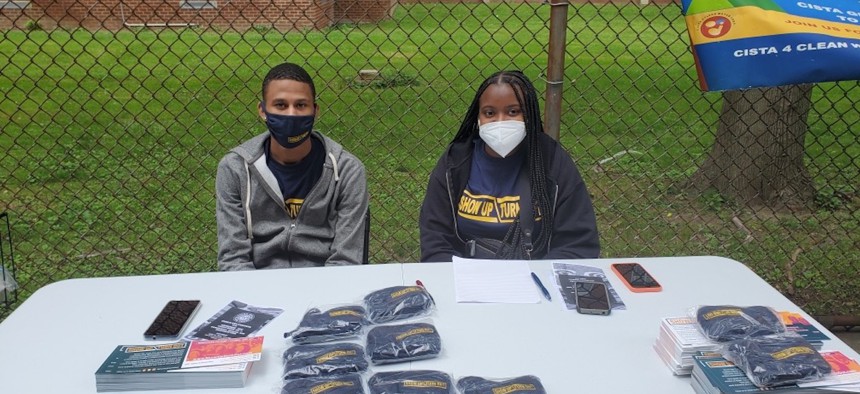With an election as close as the Democratic primary for New York City mayor – decided in Eric Adams’ favor by just 7,197 votes, or, 0.8% – it’s easy to say a lot of different things could have been the deciding factor in his win. But Show Up, Turn Out, a brand new nonprofit organization that spent more than $2 million on a campaign to convince Black New Yorkers to vote in the city election, makes a pretty strong case that Eric Adams owes them a thank you – even if barely anybody seems to know what they did.
Organizers say they targeted about 123,000 low-propensity voters – people who were registered to vote, but only cast ballots in presidential races, and never in a city election like this one. They knocked on their front doors, called them, texted them, sent mail to their homes, made digital ads appear on their screens, ran radio ads on stations they might listen to, and had organizers speak at the churches they might attend. Of the targeted voters, organizers claim that 45% of them, or 55,000 people, cast ballots in the June 2021 primary.
“If you want to impact the outcomes of government, you have to start with the ingredients,” Anthony Thomas, a political strategist who serves as executive director of Show Up, Turn Out, told City & State. “And we believe there were a lot of Black folks in particular who simply weren’t part of the process previously. I think the difference was we modified the ingredients here.”
Show Up, Turn Out’s board is made up of leaders from three of the major Black political organizations in the country: Hazel Dukes of the NAACP New York State Conference, Marc Morial of the National Urban League and Rev. Dr. W. Franklyn Richardson of the National Action Network. Those three organizations also funded the campaign, so organizers say Show Up, Turn Out barely had to take in any private donations on its own. That also allowed the organization to fly under the radar in political circles. Super PACs, known in New York City campaign finance law as Independent Expenditure Committees, have to publicly report major donors and how the money is being spent. However, Show Up, Turn Out was a different kind of campaign, registered as a 501(c)(4) nonprofit, which means that it doesn’t have to disclose its donors. It also meant that Show Up, Turn Out could not endorse any specific candidates, or encourage its audience to vote for anyone in particular. Instead, the campaign focused on voter education, including guidance on the new ranked-choice voting system and voter turnout.
Given that the ads, calls and literature didn’t tell people to vote for Eric Adams, organizers are hesitant to make the logical leap and say their targeted voters came out for the man who’s now our mayor – but it’s safe to assume an overwhelming percentage of them did. Show Up, Turn Out focused on voters living in 11 City Council districts with heavily Black populations, from Harlem and Flatbush to Southeast Queens and the North Shore of Staten Island, and voters in these districts heavily supported Adams.
“We intentionally went to people who probably shared a number of the values of ‘traditional’ Democrats – ‘traditional’ Black communities – but simply weren’t being talked to, weren’t being engaged,” Thomas said. “And you can’t just knock on somebody’s door once and hope for the best … We knew that we had to be comprehensive, offer multiple touches.”
Many in local politics were skeptical of the organization’s impact. High-level operatives for mayoral campaigns, including some on the Adams campaign, had not heard of Show, Up Turn Out, and neither had some of the City Council members whose districts were targeted by the campaign. Even those that had heard of them were skeptical of their impact, saying that voter turnout was up in this election across the board. Just over 942,000 votes were counted in the Democratic primary – the highest number since 1989.
Jake Dilemani, a political consultant with Mercury who served as the campaign’s lead strategist defended their work. “If you are not communicating with the low-propensity voters who never show up in non-presidential elections, it’s very unlikely that they show up,” he told City & State. Of course some of those voters might have come out, even without the organization’s involvement. But “can we say all 54,000 would have shown up? Of course not,” Dilemani said.
If the organization turned out the voters, they did it with little fanfare. The campaign clearly didn’t live on social media. The Twitter page has just 31 followers, only 63 people follow the Facebook page and 239 on Instagram. Those numbers are small enough to be invisible – the kind routinely surpassed by individual candidates on their first day. And Show Up, Turn Out has gotten barely any mention in the media until now. The Amsterdam News wrote a short article on the campaign’s public launch and another short piece when Rev. Al Sharpton, who founded the National Action Network, cut a video ad for the campaign.
“We do think we’re one of the best kept secrets of the primary,” Thomas told City & State.
He said Show Up, Turn Out never fleshed out their public relations strategy because they were too focused on the work. “We look at ourselves as a contribution to the city as a whole. To make it a little more robust and inclusive toward communities that are always present, but not always seen.”
NEXT STORY: Can Eric Adams really hire his brother?


